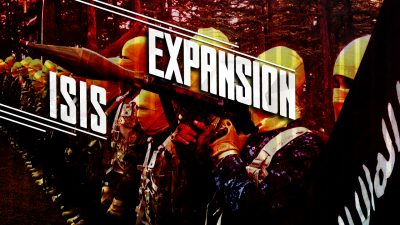
During the eight-year proxy war in Syria, Abu Mohammad al-Jolani,
the leader of al-Nusra Front, has emerged as the second most
influential militant leader after the Islamic State’s [alleged] chief Abu Bakr al-Baghdadi.
In fact, since the beginning of the Syrian conflict in August 2011 to
April 2013, the Islamic State and al-Nusra Front were a single
organization that chose the banner of Jabhat al-Nusra.
Although the current al-Nusra Front has been led by Abu Mohammad al-Jolani, he was appointed
[1] as the emir of al-Nusra Front by Abu Bakr al Baghdadi, the leader
of Islamic State, in January 2012. Thus, al-Jolani’s Nusra Front is only
a splinter group of the Islamic State, which split from its parent
organization in April 2013 over a leadership dispute between the two
organizations.
In August 2011, Abu Bakr al-Baghdadi,
who was based in Iraq, began sending Syrian and Iraqi jihadists
experienced in guerrilla warfare across the border into Syria to
establish an organization inside the country. Led by a Syrian known as
Abu Mohammad al-Jolani, the group began to recruit fighters and
establish cells throughout the country. On 23 January 2012, the group
announced its formation as Jabhat al-Nusra.
Image on the right: Abu Muhammad al-Jolani (Source: Newsweek)

In April 2013, Abu Bakr al-Baghdadi
released an audio statement in which he announced that al-Nusra Front
had been established, financed and supported by the Islamic State of
Iraq. Al-Baghdadi declared that the two groups were merging under the
name “Islamic State of Iraq and Syria.” The leader of al-Nusra Front,
Abu Muhammad al-Jolani, issued a statement denying the merger and
complaining that neither he nor anyone else in al-Nusra’s leadership had
been consulted about it.
Al-Qaeda Central’s leader, Ayman al Zawahiri,
tried to mediate the dispute between al-Baghdadi and al-Jolani but
eventually, in October 2013, he endorsed al-Nusra Front as the official
franchise of al-Qaeda Central in Syria. Abu Bakr al-Baghdadi, however,
defied the nominal authority of al-Qaeda Central and declared himself as
the caliph of the Islamic State of Iraq and Syria.
Keeping this background in mind, it
becomes abundantly clear that a single militant organization operated in
Syria and Iraq under the leadership of al-Baghdadi until April 2013,
which chose the banner of al-Nusra Front, and that the current emir of
the subsequent breakaway faction of al-Nusra Front, al-Jolani, was
actually al-Baghdadi’s deputy in Syria.
Thus, the Islamic State operated in
Syria since August 2011 under the designation of al-Nusra Front and it
subsequently changed its name to the Islamic State of Iraq and Syria
(ISIS) in April 2013, after which it overran Raqqa and parts of Deir
al-Zor in the summer of 2013. And in January 2014, it overran Fallujah
and parts of Ramadi in Iraq and reached the zenith of its power when it
captured Mosul in June 2014.
Image below: Abu Bakr al-Baghdadi (Source: Ariana News)

Excluding al-Baghdadi and a handful of
his hardline Islamist aides, the rest of Islamic State’s top leadership
was comprised of Saddam-era military and intelligence officials.
According to an informative Associated Press report
[2], hundreds of ex-Baathists constituted the top and mid-tier command
structure of the Islamic State who planned all the operations and
directed its military strategy.
More to the point, it is an
indisputable fact that morale and ideology play an important role in
battlefield, and well-informed readers must also be aware that the
Takfiri brand of most jihadists these days has directly been inspired by
the puritanical Wahhabi-Salafi ideology of Saudi Arabia, but ideology
alone is not sufficient to succeed in battle.
Looking at the Islamic State’s
astounding gains in Syria and Iraq in 2013-14, a question arises that
where did its recruits get all the training and state-of-the-art weapons
that were imperative not only for hit-and-run guerrilla warfare but
also for capturing and holding large swathes of territory in Syria and
Iraq.
According to a revelatory December 2013 news report
[3] from a newspaper affiliated with the UAE government which supports
the Syrian opposition, it is clearly mentioned that along with AK-47s,
rocket-propelled grenades and other military gear, the Saudi regime also
provided machine gun-mounted Toyota pick-up trucks to every batch of
five jihadists who had completed their training in the training camps
located in Jordan’s border regions along southern Syria.
Once those militants crossed over to
Daraa and Quneitra in southern Syria from the Jordan-Syria border, then
those Toyota pickup trucks could easily have traveled all the way to
Raqqa and Deir al-Zor in eastern Syria, and thence to Mosul and Anbar in
Iraq.
Moreover, it is clearly spelled out in
the report that Syrian militants got arms and training through a secret
command center known as the Military Operations Center (MOC) based in
the intelligence headquarters’ building in Amman, Jordan that was
staffed by high-ranking military officials from 14 countries, including
the US, European nations, Israel and the Gulf states to wage a covert
war against Damascus.
Regarding the Syrian opposition, a
small fraction of it was comprised of defected Syrian soldiers who went
by the name of Free Syria Army, but the vast majority was comprised of
Islamic jihadists and armed tribesmen who were generously funded,
trained, armed and internationally legitimized by their regional and
international patrons.
The Islamic State was nothing more
than one of numerous Syrian militant outfits, others being: al Nusra
Front, Ahrar al-Sham, al-Tawhid brigade, Jaysh al Islam etc. All the
militant groups that operated in Syria were just as fanatical and brutal
as the Islamic State. The only feature that differentiated the Islamic
State from the rest was that it was more ideological and
independent-minded.
The reason why the US declared war
against the Islamic State was that all other Syrian militant outfits
simply had local ambitions that were limited to fighting the Syrian
government, whereas the Islamic State had established a global network
of transnational terrorists that included hundreds of Western citizens
who became a national security risk to the Western countries.
Regarding the dominant group of Syrian militants in Syria’s northwestern Idlib Governorate, according to a May 2017 report
[4] by CBC Canada, Hayat Tahrir al-Sham (HTS), which was formerly known
as al-Nusra Front until July 2016 and then as Jabhat Fateh al-Sham
(JFS) until January 2017, had been removed from the terror watch-lists
of the US and Canada after it merged with fighters from Zenki Brigade
and hardline jihadists from Ahrar al-Sham and rebranded itself as Hayat
Tahrir al-Sham (HTS) in January 2017.
The US State Department was hesitant
to label Hayat Tahrir al-Sham (HTS) a terror group, despite the group’s
links to al-Qaeda, as the US government had directly funded and armed
the Zenki Brigade, one of the constituents of Hayat Tahrir al-Sham
(HTS), with sophisticated weaponry including the US-made antitank
missiles.
Although after the report was
published in CBC News, Canada added the name of HTS to its terror
watch-list in May 2018, Turkey designated it a terrorist organization in
August 2018 and Washington came up with the excuse that since HTS is a
merger of several militant outfits, and one of those militant groups,
al-Nusra Front, was already on the terror watch-list of the US,
therefore it too regards HTS a terrorist organization.
Nevertheless, the purpose behind the
rebranding of al-Nusra Front, first as Jabhat Fateh al-Sham (JFS) in
July 2016 and then as Hayat Tahrir al-Sham (HTS) in January 2017 and
purported severing of ties with al-Qaeda, was to legitimize itself and
to make it easier for its patrons to send money and arms.
Washington blacklisted al-Nusra Front
in December 2012 and persuaded its regional allies Saudi Arabia and
Turkey to ban it, too. Although al-Nusra Front’s name had been in the
list of proscribed organizations of Saudi Arabia and Turkey since 2014,
it kept receiving money and arms from its regional patrons.
It’s worth noting that in a May 2015 interview
[5] with Qatar’s state television al-Jazeera, Abu Mohammad al-Jolani
took a public pledge on the behest of his Gulf-based patrons that his
organization simply had local ambitions limited to fighting the Syrian
government and that it had no intention to mount terror attacks in the
Western countries.
Although al-Jolani announced the split
from al-Qaeda in a video statement in 2016, the persistent efforts of
al-Jolani’s Gulf-based patrons bore fruit in January 2017, when al-Nusra
Front once again rebranded itself from Jabhat Fateh al-Sham (JFS) to
Hayat Tahrir al-Sham (HTS), which also included “moderate jihadists”
from Zenki Brigade, Ahrar al-Sham and several other militant groups, and
thus the jihadist conglomerate that now goes by the name of Hayat
Tahrir al-Sham was able to overrun the northwestern Idlib Governorate in
Syria, and it completely routed the Turkey-backed militants in a brazen
offensive in Idlib last month.
*
Note to readers: please click the share
buttons below. Forward this article to your email lists. Crosspost on
your blog site, internet forums. etc.
Nauman Sadiq is an
Islamabad-based attorney, columnist and geopolitical analyst focused on
the politics of Af-Pak and Middle East regions, neocolonialism and
petro-imperialism.
Notes
[1] Al-Jolani was appointed as the emir of al-Nusra Front by al-Baghdadi:
[2] Islamic State’s top command dominated by ex-officers in Saddam’s army:
[3] Syrian rebels get arms and advice through secret command center in Amman:
[4] Syria’s al-Qaeda affiliate escapes from terror list:
[5] Al-Jolani’s interview to Al-Jazeera: “Our mission is to defeat the Syrian government”:
The original source of this article is Global Research
Copyright © Nauman Sadiq, Global Research, 2019













